Comparative Analysis of Deep Learning and Swarm-Optimized Random Forest for Groundwater Spring Potential Identification in Tropical Regions
Abstract
:1. Introduction
2. Background of the Methods Used
2.1. Deep Neural Networks
2.2. Random Forest
2.3. Swarm-Based Optimization Algorithm
- ▪
- Step 1: This step involves determining the population size (N) and creating a three-dimensional search space for the parameters. In the searching space, the position of each hawk is defined by its coordinates (nTree, dTree, and fTree), representing a solution within the RF model. Subsequently, a cost function is defined to evaluate and measure the fitness of each solution.
- ▪
- Step 2: In this step, the fitness of each hawk in the swarm is calculated. Following that, the search phase is executed, wherein the position of the hawks is updated using Equation (1) [43]:
- ▪
- Step 3: Compute the escape energy (E) using Equation (3) as follows:
- ▪
- Step 4: Termination: the algorithm halts when a termination criterion is satisfied, which can be defined as reaching the maximum number of iterations or attaining the desired fitness level.
3. Study Area and Data
3.1. Study Area
3.2. Groundwater Spring Locations
3.3. Groundwater Spring Influencing Factors
4. Proposed Methodology for Comparative Analysis of Deep Learning and Swarm-Optimized Random Forest for Groundwater Spring Potential Identification
- Step 1. Construction of the groundwater spring database.
- Step 2. Feature selection with the wrapper method.
- Step 3. Groundwater spring potential modeling with deep learning.
- Step 4. Groundwater spring potential modeling with swarm-optimized random forest.
- Step 5. Performance assessment.
5. Results and Analysis
5.1. Variable Importance
5.2. Model Training and Validation
5.3. Statistical Test
5.4. Compile the Forest Fire Danger Map
6. Discussions
7. Concluding Remarks
- ▪
- Both deep neural networks and random forests have been identified as powerful methods for the spatial prediction of groundwater spring potential.
- ▪
- The random forests model optimized by the HHO algorithm (referred to as SwarmRF) exhibits a slight superiority in terms of prediction capability compared to the deep neural network (DeepNN) model.
- ▪
- Geology stands out as the most influential factor contributing to groundwater potential mapping.
Author Contributions
Funding
Data Availability Statement
Conflicts of Interest
References
- Famiglietti, J.S. The global groundwater crisis. Nat. Clim. Chang. 2014, 4, 945–948. [Google Scholar] [CrossRef]
- Wang, T.; Wu, Z.; Wang, P.; Wu, T.; Zhang, Y.; Yin, J.; Yu, J.; Wang, H.; Guan, X.; Xu, H.; et al. Plant-groundwater interactions in drylands: A review of current research and future perspectives. Agric. For. Meteorol. 2023, 341, 109636. [Google Scholar] [CrossRef]
- Fan, Y.; Miguez-Macho, G.; Jobbágy, E.G.; Jackson, R.B.; Otero-Casal, C. Hydrologic regulation of plant rooting depth. Proc. Natl. Acad. Sci. USA 2017, 114, 10572–10577. [Google Scholar] [CrossRef] [PubMed]
- Bierkens, M.F.; Wada, Y. Non-renewable groundwater use and groundwater depletion: A review. Environ. Res. Lett. 2019, 14, 063002. [Google Scholar] [CrossRef]
- Avila Velasquez, D.I.; Pulido-Velazquez, M.; Hector, M.-S. Improvement of water management for irrigation in Mediterranean basins combining remote sensing, weather forecasting, and artificial intelligence. In Proceedings of the Online Youth Water Congress: “Emerging Water Challenges since COVID-19”, Online, 6–8 April 2022; p. 58. [Google Scholar]
- Amadori, M.; Zamparelli, V.; De Carolis, G.; Fornaro, G.; Toffolon, M.; Bresciani, M.; Giardino, C.; De Santi, F. Monitoring Lakes Surface Water Velocity with SAR: A Feasibility Study on Lake Garda, Italy. Remote Sens. 2021, 13, 2293. [Google Scholar] [CrossRef]
- Sentas, A.; Karamoutsou, L.; Charizopoulos, N.; Psilovikos, T.; Psilovikos, A.; Loukas, A. The use of stochastic models for short-term prediction of water parameters of the Thesaurus dam, River Nestos, Greece. Proceedings 2018, 2, 634. [Google Scholar]
- Jasechko, S.; Seybold, H.; Perrone, D.; Fan, Y.; Kirchner, J.W. Widespread potential loss of streamflow into underlying aquifers across the USA. Nature 2021, 591, 391–395. [Google Scholar] [CrossRef] [PubMed]
- Dalin, C.; Wada, Y.; Kastner, T.; Puma, M.J. Groundwater depletion embedded in international food trade. Nature 2017, 543, 700–704. [Google Scholar] [CrossRef]
- Scanlon, B.R.; Fakhreddine, S.; Rateb, A.; de Graaf, I.; Famiglietti, J.; Gleeson, T.; Grafton, R.Q.; Jobbagy, E.; Kebede, S.; Kolusu, S.R. Global water resources and the role of groundwater in a resilient water future. Nat. Rev. Earth Environ. 2023, 4, 87–101. [Google Scholar] [CrossRef]
- Baghban, S.; Bozorg-Haddad, O.; Berndtsson, R. Water security. In Water Resources: Future Perspectives, Challenges, Concepts and Necessities; IWA Publishing: London, UK, 2021; p. 205. [Google Scholar]
- He, C.; Liu, Z.; Wu, J.; Pan, X.; Fang, Z.; Li, J.; Bryan, B.A. Future global urban water scarcity and potential solutions. Nat. Commun. 2021, 12, 4667. [Google Scholar] [CrossRef]
- Chenini, I.; Mammou, A.B. Groundwater recharge study in arid region: An approach using GIS techniques and numerical modeling. Comput. Geosci. 2010, 36, 801–817. [Google Scholar] [CrossRef]
- Saravanan, R.; Balamurugan, R.; Karthikeyan, M.S.; Rajkumar, R.; Anuthaman, N.G.; Navaneetha Gopalakrishnan, A. Groundwater modeling and demarcation of groundwater protection zones for Tirupur Basin—A case study. J. Hydro-Environ. Res. 2011, 5, 197–212. [Google Scholar] [CrossRef]
- Corsini, A.; Cervi, F.; Ronchetti, F. Weight of evidence and artificial neural networks for potential groundwater spring mapping: An application to the Mt. Modino area (Northern Apennines, Italy). Geomorphology 2009, 111, 79–87. [Google Scholar] [CrossRef]
- Mogaji, K.; Omosuyi, G.; Adelusi, A.; Lim, H. Application of GIS-based evidential belief function model to regional groundwater recharge potential zones mapping in hardrock geologic terrain. Environ. Process. 2016, 3, 93–123. [Google Scholar] [CrossRef]
- Ozdemir, A. Using a binary logistic regression method and GIS for evaluating and mapping the groundwater spring potential in the Sultan Mountains (Aksehir, Turkey). J. Hydrol. 2011, 405, 123–136. [Google Scholar] [CrossRef]
- Golkarian, A.; Naghibi, S.A.; Kalantar, B.; Pradhan, B. Groundwater potential mapping using C5.0, random forest, and multivariate adaptive regression spline models in GIS. Environ. Monit. Assess. 2018, 190, 149. [Google Scholar] [CrossRef] [PubMed]
- Machiwal, D.; Jha, M.K.; Mal, B.C. Assessment of groundwater potential in a semi-arid region of India using remote sensing, GIS and MCDM techniques. Water Resour. Manag. 2011, 25, 1359–1386. [Google Scholar] [CrossRef]
- Arulbalaji, P.; Padmalal, D.; Sreelash, K. GIS and AHP techniques based delineation of groundwater potential zones: A case study from southern Western Ghats, India. Sci. Rep. 2019, 9, 2082. [Google Scholar] [CrossRef] [PubMed]
- Pham, Q.B.; Tran, D.A.; Ha, N.T.; Islam, A.R.M.T.; Salam, R. Random forest and nature-inspired algorithms for mapping groundwater nitrate concentration in a coastal multi-layer aquifer system. J. Clean. Prod. 2022, 343, 130900. [Google Scholar] [CrossRef]
- Bien, T.X.; Jaafari, A.; Van Phong, T.; Trinh, P.T.; Pham, B.T. Groundwater potential mapping in the Central Highlands of Vietnam using spatially explicit machine learning. Earth Sci. Inform. 2023, 16, 131–146. [Google Scholar] [CrossRef]
- Bai, Z.; Liu, Q.; Liu, Y. Groundwater potential mapping in hubei region of china using machine learning, ensemble learning, deep learning and automl methods. Nat. Resour. Res. 2022, 31, 2549–2569. [Google Scholar] [CrossRef]
- Das, R.; Saha, S. Spatial mapping of groundwater potentiality applying ensemble of computational intelligence and machine learning approaches. Groundw. Sustain. Dev. 2022, 18, 100778. [Google Scholar] [CrossRef]
- Ijlil, S.; Essahlaoui, A.; Mohajane, M.; Essahlaoui, N.; Mili, E.M.; Van Rompaey, A. Machine learning algorithms for modeling and mapping of groundwater pollution risk: A study to reach water security and sustainable development (Sdg) goals in a mediterranean aquifer system. Remote Sens. 2022, 14, 2379. [Google Scholar] [CrossRef]
- Chen, Y.; Chen, W.; Chandra Pal, S.; Saha, A.; Chowdhuri, I.; Adeli, B.; Janizadeh, S.; Dineva, A.A.; Wang, X.; Mosavi, A. Evaluation efficiency of hybrid deep learning algorithms with neural network decision tree and boosting methods for predicting groundwater potential. Geocarto Int. 2022, 37, 5564–5584. [Google Scholar] [CrossRef]
- Hakim, W.L.; Nur, A.S.; Rezaie, F.; Panahi, M.; Lee, C.-W.; Lee, S. Convolutional neural network and long short-term memory algorithms for groundwater potential mapping in Anseong, South Korea. J. Hydrol. Reg. Stud. 2022, 39, 100990. [Google Scholar] [CrossRef]
- Sashikkumar, M.; Selvam, S.; Kalyanasundaram, V.L.; Johnny, J.C. GIS based groundwater modeling study to assess the effect of artificial recharge: A case study from Kodaganar river basin, Dindigul district, Tamil Nadu. J. Geol. Soc. India 2017, 89, 57–64. [Google Scholar] [CrossRef]
- Goyal, D.; Haritash, A.; Singh, S. A comprehensive review of groundwater vulnerability assessment using index-based, modelling, and coupling methods. J. Environ. Manag. 2021, 296, 113161. [Google Scholar] [CrossRef] [PubMed]
- Jaafarzadeh, M.S.; Tahmasebipour, N.; Haghizadeh, A.; Pourghasemi, H.R.; Rouhani, H. Groundwater recharge potential zonation using an ensemble of machine learning and bivariate statistical models. Sci. Rep. 2021, 11, 5587. [Google Scholar] [CrossRef]
- Deng, C.; Zhang, Y.; Bailey, R.T. Evaluating crop-soil-water dynamics in waterlogged areas using a coupled groundwater-agronomic model. Environ. Model. Softw. 2021, 143, 105130. [Google Scholar] [CrossRef]
- Farhat, B.; Souissi, D.; Mahfoudhi, R.; Chrigui, R.; Sebei, A.; Ben Mammou, A. GIS-based multi-criteria decision-making techniques and analytical hierarchical process for delineation of groundwater potential. Environ. Monit. Assess. 2023, 195, 285. [Google Scholar] [CrossRef]
- Tao, H.; Hameed, M.M.; Marhoon, H.A.; Zounemat-Kermani, M.; Salim, H.; Sungwon, K.; Sulaiman, S.O.; Tan, M.L.; Sa’adi, Z.; Mehr, A.D.; et al. Groundwater level prediction using machine learning models: A comprehensive review. Neurocomputing 2022, 489, 271–308. [Google Scholar] [CrossRef]
- Zaresefat, M.; Derakhshani, R. Revolutionizing groundwater management with hybrid AI models: A practical review. Water 2023, 15, 1750. [Google Scholar] [CrossRef]
- Naghibi, S.A.; Ahmadi, K.; Daneshi, A. Application of support vector machine, random forest, and genetic algorithm optimized random forest models in groundwater potential mapping. Water Resour. Manag. 2017, 31, 2761–2775. [Google Scholar] [CrossRef]
- Knoll, L.; Breuer, L.; Bach, M. Large scale prediction of groundwater nitrate concentrations from spatial data using machine learning. Sci. Total Environ. 2019, 668, 1317–1327. [Google Scholar] [CrossRef] [PubMed]
- Kumar, S.; Pati, J. Assessment of groundwater arsenic contamination level in Jharkhand, India using machine learning. J. Comput. Sci. 2022, 63, 101779. [Google Scholar] [CrossRef]
- Chen, W.; Li, Y.; Tsangaratos, P.; Shahabi, H.; Ilia, I.; Xue, W.; Bian, H. Groundwater Spring Potential Mapping Using Artificial Intelligence Approach Based on Kernel Logistic Regression, Random Forest, and Alternating Decision Tree Models. Appl. Sci. 2020, 10, 425. [Google Scholar] [CrossRef]
- Kumari, S.; Kumar, D.; Kumar, M.; Pande, C.B. Modeling of standardized groundwater index of Bihar using machine learning techniques. Phys. Chem. Earth Parts A/B/C 2023, 130, 103395. [Google Scholar] [CrossRef]
- Panahi, M.; Sadhasivam, N.; Pourghasemi, H.R.; Rezaie, F.; Lee, S. Spatial prediction of groundwater potential mapping based on convolutional neural network (CNN) and support vector regression (SVR). J. Hydrol. 2020, 588, 125033. [Google Scholar] [CrossRef]
- Moughani, S.K.; Osmani, A.; Nohani, E.; Khoshtinat, S.; Jalilian, T.; Askari, Z.; Heddam, S.; Tiefenbacher, J.P.; Hatamiafkoueieh, J. Groundwater spring potential prediction using a deep-learning algorithm. Acta Geophys. 2023. [Google Scholar] [CrossRef]
- Wang, Z.; Wang, J.; Han, J. Spatial prediction of groundwater potential and driving factor analysis based on deep learning and geographical detector in an arid endorheic basin. Ecol. Indic. 2022, 142, 109256. [Google Scholar] [CrossRef]
- Heidari, A.A.; Mirjalili, S.; Faris, H.; Aljarah, I.; Mafarja, M.; Chen, H. Harris hawks optimization: Algorithm and applications. Future Gener. Comput. Syst. 2019, 97, 849–872. [Google Scholar] [CrossRef]
- Tien Bui, D.; Hoang, N.-D.; Martínez-Álvarez, F.; Ngo, P.-T.T.; Hoa, P.V.; Pham, T.D.; Samui, P.; Costache, R. A novel deep learning neural network approach for predicting flash flood susceptibility: A case study at a high frequency tropical storm area. Sci. Total Environ. 2020, 701, 134413. [Google Scholar] [CrossRef] [PubMed]
- Truong, T.X.; Nhu, V.-H.; Phuong, D.T.N.; Nghi, L.T.; Hung, N.N.; Hoa, P.V.; Bui, D.T. A New Approach Based on TensorFlow Deep Neural Networks with ADAM Optimizer and GIS for Spatial Prediction of Forest Fire Danger in Tropical Areas. Remote Sens. 2023, 15, 3458. [Google Scholar] [CrossRef]
- Mazurowski, M.A.; Buda, M.; Saha, A.; Bashir, M.R. Deep learning in radiology: An overview of the concepts and a survey of the state of the art with focus on MRI. J. Magn. Reson. Imaging 2019, 49, 939–954. [Google Scholar] [CrossRef] [PubMed]
- Karamoutsou, L.; Psilovikos, A. Deep Learning in Water Resources Management: Τhe Case Study of Kastoria Lake in Greece. Water 2021, 13, 3364. [Google Scholar] [CrossRef]
- Cano, A. A survey on graphic processing unit computing for large-scale data mining. Wiley Interdiscip. Rev. Data Min. Knowl. Discov. 2018, 8, e1232. [Google Scholar] [CrossRef]
- Liu, M.; Wu, W.; Gu, Z.; Yu, Z.; Qi, F.; Li, Y. Deep learning based on batch normalization for P300 signal detection. Neurocomputing 2018, 275, 288–297. [Google Scholar] [CrossRef]
- Breiman, L. Random forests. Mach. Learn. 2001, 45, 5–32. [Google Scholar] [CrossRef]
- Santos, K.; Dias, J.P.; Amado, C. A literature review of machine learning algorithms for crash injury severity prediction. J. Saf. Res. 2022, 80, 254–269. [Google Scholar] [CrossRef]
- Tyralis, H.; Papacharalampous, G.; Langousis, A. A brief review of random forests for water scientists and practitioners and their recent history in water resources. Water 2019, 11, 910. [Google Scholar] [CrossRef]
- Speiser, J.L.; Miller, M.E.; Tooze, J.; Ip, E. A comparison of random forest variable selection methods for classification prediction modeling. Expert Syst. Appl. 2019, 134, 93–101. [Google Scholar] [CrossRef] [PubMed]
- Wang, X.; Dong, X.; Zhang, Y.; Chen, H. Crisscross Harris hawks optimizer for global tasks and feature selection. J. Bionic Eng. 2023, 20, 1153–1174. [Google Scholar] [CrossRef] [PubMed]
- Alabool, H.M.; Alarabiat, D.; Abualigah, L.; Heidari, A.A. Harris hawks optimization: A comprehensive review of recent variants and applications. Neural Comput. Appl. 2021, 33, 8939–8980. [Google Scholar] [CrossRef]
- Peng, L.; Cai, Z.; Heidari, A.A.; Zhang, L.; Chen, H. Hierarchical Harris hawks optimizer for feature selection. J. Adv. Res. 2023, in press. [Google Scholar] [CrossRef] [PubMed]
- Truong, T.X.; Phuong, N.D.T.; Nghi, L.T.; Nhu, V.-H. A novel HHO-RSCDT ensemble learning approach for forest fire danger mapping using GIS. Vietnam. J. Earth Sci. 2023, 45, 338–356. [Google Scholar]
- Le, H.; Bui, Q.; Bui, D.T.; Tran, H.H.; Hoang, N. A Hybrid Intelligence System Based on Relevance Vector Machines and Imperialist Competitive Optimization for Modelling Forest Fire Danger Using GIS. J. Environ. Inform. 2020, 36, 43–57. [Google Scholar] [CrossRef]
- Van, N.K.; Ly, P.T.; Hong, N.T. Bioclimatic map of Tay Nguyen at scale 1: 250,000 for setting up sustainable ecological economic models. Vietnam. J. Earth Sci. 2014, 36, 504–514. [Google Scholar] [CrossRef]
- Tum, K.; Lai, G.; Lak, D. The Drought Crisis in the Central Highlands of Vietnam; CGIAR Research Program on Climate Change, Agriculture and Food Security (CCAFS): Hanoi, Vietnam, 2016. [Google Scholar]
- Tran, T.V.; Bruce, D.; Huang, C.-Y.; Tran, D.X.; Myint, S.W.; Nguyen, D.B. Decadal assessment of agricultural drought in the context of land use land cover change using MODIS multivariate spectral index time-series data. GIScience Remote Sens. 2023, 60, 2163070. [Google Scholar] [CrossRef]
- Hiep, N.V.; Ha, N.T.; Thuy, T.T.T.; Van Toan, P. Isolation and selection of Arthrobotrys nematophagous fungi to control the nematodes on coffee and black pepper plants in Vietnam. Arch. Phytopathol. Plant Prot. 2019, 52, 825–843. [Google Scholar] [CrossRef]
- Viossanges, M.; Pavelic, P.; Hoanh, C.T.; Vinh, B.; Chung, D.; D’haeze, D.; Dat, L. Linkages between Irrigation Practices and Groundwater Availability: Evidence from the Krong Buk Micro-Catchment, Dak Lak-Vietnam. Final Technical Report. [Contribution to WLE project-Sustainable Groundwater]; International Water Management Institute (IWMI): Colombo, Sri Lanka, 2019. [Google Scholar]
- Tam, H.T.; Linh, D.P. How minor immigrants became the dominants: The case of the Kinh people migrating to the Central Highlands, Vietnam in the twentieth century. Soc. Identities 2022, 28, 608–627. [Google Scholar] [CrossRef]
- Kresic, N. Chapter 2—Types and classifications of springs. In Groundwater Hydrology of Springs, Kresic, N., Stevanovic, Z., Eds.; Butterworth-Heinemann: Boston, MA, USA, 2010; pp. 31–85. [Google Scholar] [CrossRef]
- Haldorsen, S.; Englund, J.-O.; Kirkhusmo, L.A. Groundwater springs in the Hedmarksvidda mountains related to the deglaciation history. Nor. Geol. Tidsskr. 1993, 73, 234–242. [Google Scholar]
- Canh, D.V.; Thuy, N.T.T.; Xuan, N.T.; Luat, N.Q.; Nhan, P.Q.; Binh, D.V.; Hue, T.T.; Nhan, D.D.; Tu, N.T.; Long, D.D.; et al. Research on Scientific Basis and Develop Solutions to Store Rainwater into the Ground for Drought Prevention and Protection of Underground Water Resources in the Central Highlands. No. DTDL.2007G/44; Hanoi University of Mining and Geology: Ha Noi, Vietnam, 2010. [Google Scholar]
- Duong, H.H.; Lam, N.X.; Tu, N.T.; Tho, H.M.; Phong, N.T.; Tang, N.X.; Thuan, H.L.; Long, N.L.; Hoan, H.V.; Trinh, T.D.; et al. Research and Propose Models and Technological Solutions to Exploit and Protect Water Sources in Basalt Formations in High-Mountainous and Water-Scarcity Areas in the Central Highlands. No. DTDL.CN-65/15; Vietnam Academy for Water Resources: Ha Noi, Vietnam, 2018. [Google Scholar]
- Vinh, P.T.; Hai, D.D.; Thanh, T.T.; Huan, K.V.; Giang, V.N.H.; Huyen, T.D.; Chan, N.D.; Nam, P.C.; Tu, N.T.; Luu, N. Research and Propose Models of Collection and Sustainable Exploitation of Spring Groundwater for High-Mountain and Water-Scarces Areas in the Central Highlands. No. DTDL.CN-64/15; Vietnam Academy for Water Resources: Hanoi, Vietnam, 2018. [Google Scholar]
- Ozdemir, A. GIS-based groundwater spring potential mapping in the Sultan Mountains (Konya, Turkey) using frequency ratio, weights of evidence and logistic regression methods and their comparison. J. Hydrol. 2011, 411, 290–308. [Google Scholar] [CrossRef]
- Tóth, J. Groundwater as a geologic agent: An overview of the causes, processes, and manifestations. Hydrogeol. J. 1999, 7, 1–14. [Google Scholar] [CrossRef]
- Lambin, E.F.; Rounsevell, M.D.; Geist, H.J. Are agricultural land-use models able to predict changes in land-use intensity? Agric. Ecosyst. Environ. 2000, 82, 321–331. [Google Scholar] [CrossRef]
- Lazzarini, M.; Molini, A.; Marpu, P.R.; Ouarda, T.B.; Ghedira, H. Urban climate modifications in hot desert cities: The role of land cover, local climate, and seasonality. Geophys. Res. Lett. 2015, 42, 9980–9989. [Google Scholar] [CrossRef]
- Jyrkama, M.I.; Sykes, J.F. The impact of climate change on spatially varying groundwater recharge in the grand river watershed (Ontario). J. Hydrol. 2007, 338, 237–250. [Google Scholar] [CrossRef]
- Myers, T. Potential contaminant pathways from hydraulically fractured shale to aquifers. Groundwater 2012, 50, 872–882. [Google Scholar] [CrossRef]
- Sear, D.; Armitage, P.; Dawson, F. Groundwater dominated rivers. Hydrol. Process. 1999, 13, 255–276. [Google Scholar] [CrossRef]
- Scibek, J.; Allen, D. Modeled impacts of predicted climate change on recharge and groundwater levels. Water Resour. Res. 2006, 42, W11405. [Google Scholar] [CrossRef]
- Liao, F.; Wang, G.; Yang, N.; Shi, Z.; Li, B.; Chen, X. Groundwater discharge tracing for a large Ice-Covered lake in the Tibetan Plateau: Integrated satellite remote sensing data, chemical components and isotopes (D, 18O, and 222Rn). J. Hydrol. 2022, 609, 127741. [Google Scholar] [CrossRef]
- Mandal, U.; Sahoo, S.; Munusamy, S.B.; Dhar, A.; Panda, S.N.; Kar, A.; Mishra, P.K. Delineation of groundwater potential zones of coastal groundwater basin using multi-criteria decision making technique. Water Resour. Manag. 2016, 30, 4293–4310. [Google Scholar] [CrossRef]
- Mallick, J.; Talukdar, S.; Ahmed, M. Combining high resolution input and stacking ensemble machine learning algorithms for developing robust groundwater potentiality models in Bisha watershed, Saudi Arabia. Appl. Water Sci. 2022, 12, 77. [Google Scholar] [CrossRef]
- Mahato, S.; Pal, S. Groundwater Potential Mapping in a Rural River Basin by Union (OR) and Intersection (AND) of Four Multi-criteria Decision-Making Models. Nat. Resour. Res. 2019, 28, 523–545. [Google Scholar] [CrossRef]
- Defries, R.S.; Townshend, J.R.G. NDVI-derived land cover classifications at a global scale. Int. J. Remote Sens. 1994, 15, 3567–3586. [Google Scholar] [CrossRef]
- Gao, B.-C. NDWI—A normalized difference water index for remote sensing of vegetation liquid water from space. Remote Sens. Environ. 1996, 58, 257–266. [Google Scholar] [CrossRef]
- Xu, H. Modification of normalised difference water index (NDWI) to enhance open water features in remotely sensed imagery. Int. J. Remote Sens. 2006, 27, 3025–3033. [Google Scholar] [CrossRef]
- Fauzia; Surinaidu, L.; Rahman, A.; Ahmed, S. Distributed groundwater recharge potentials assessment based on GIS model and its dynamics in the crystalline rocks of South India. Sci. Rep. 2021, 11, 11772. [Google Scholar] [CrossRef]
- McVicar, T.R.; Van Niel, T.G.; Li, L.; Hutchinson, M.F.; Mu, X.; Liu, Z. Spatially distributing monthly reference evapotranspiration and pan evaporation considering topographic influences. J. Hydrol. 2007, 338, 196–220. [Google Scholar] [CrossRef]
- Khosravi, K.; Panahi, M.; Tien Bui, D. Spatial prediction of groundwater spring potential mapping based on an adaptive neuro-fuzzy inference system and metaheuristic optimization. Hydrol. Earth Syst. Sci. 2018, 22, 4771–4792. [Google Scholar] [CrossRef]
- Troch, P.; van Loon, E.; Hilberts, A. Analytical solutions to a hillslope-storage kinematic wave equation for subsurface flow. Adv. Water Resour. 2002, 25, 637–649. [Google Scholar] [CrossRef]
- Bui, D.T.; Bui, Q.-T.; Nguyen, Q.-P.; Pradhan, B.; Nampak, H.; Trinh, P.T. A hybrid artificial intelligence approach using GIS-based neural-fuzzy inference system and particle swarm optimization for forest fire susceptibility modeling at a tropical area. Agric. For. Meteorol. 2017, 233, 32–44. [Google Scholar]
- Kohavi, R.; John, G.H. Wrappers for feature subset selection. Artif. Intell. 1997, 97, 273–324. [Google Scholar] [CrossRef]
- Maldonado, J.; Riff, M.C.; Neveu, B. A review of recent approaches on wrapper feature selection for intrusion detection. Expert Syst. Appl. 2022, 198, 116822. [Google Scholar] [CrossRef]
- Liu, W.; Wang, J. Recursive elimination–election algorithms for wrapper feature selection. Appl. Soft Comput. 2021, 113, 107956. [Google Scholar] [CrossRef]
- Kingma, D.; Ba, J. Adam: A method for stochastic optimization. In Proceedings of the 3rd International Conference for Learning Representations (ICLR’15), San Diego, CA, USA, 7–9 May 2015; Volume 500. [Google Scholar]
- Msaddek, M.H.; Ben Alaya, M.; Moumni, Y.; Ayari, A.; Chenini, I. Enhanced machine learning model to estimate groundwater spring potential based on digital elevation model parameters. Geocarto Int. 2022, 37, 8815–8841. [Google Scholar] [CrossRef]
- Woolson, R.F. Wilcoxon signed-rank test. In Wiley Encyclopedia of Clinical Trials; John Wiley & Sons, Inc.: Hoboken, NJ, USA, 2007; pp. 1–3. [Google Scholar]
- Van Quang, N.; Thanh, N.H. Local government response capacity to natural disasters in the Central Highlands Provinces, Vietnam. Humanit. Soc. Sci. Commun. 2023, 10, 209. [Google Scholar] [CrossRef]
- Hale, M.; Plant, J.A. Drainage Geochemistry; Elsevier: Amsterdam, The Netherlands, 2013. [Google Scholar]
- Akhtar, N.; Syakir, M.I.; Anees, M.T.; Qadir, A.; Yusuff, M.S. Characteristics and assessment of groundwater. In Groundwater Management and Resources; IntechOpen: London, UK, 2020. [Google Scholar]
- Wu, C.; Gu, L.; Zhang, Z.; Ren, Z.; Chen, Z.; Li, W. Formation mechanisms of hydrocarbon reservoirs associated with volcanic and subvolcanic intrusive rocks: Examples in Mesozoic–Cenozoic basins of eastern China. AAPG Bull. 2006, 90, 137–147. [Google Scholar]
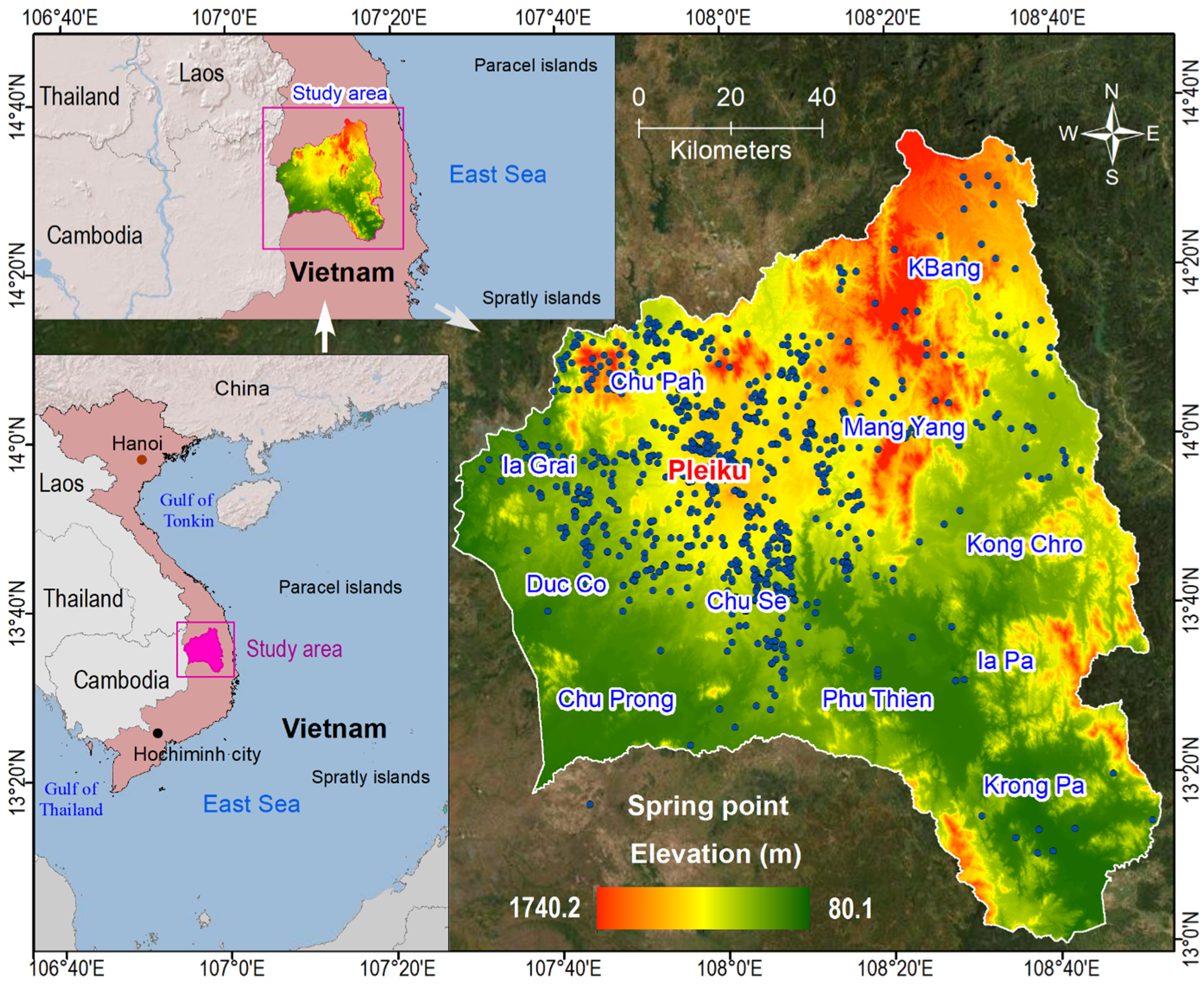
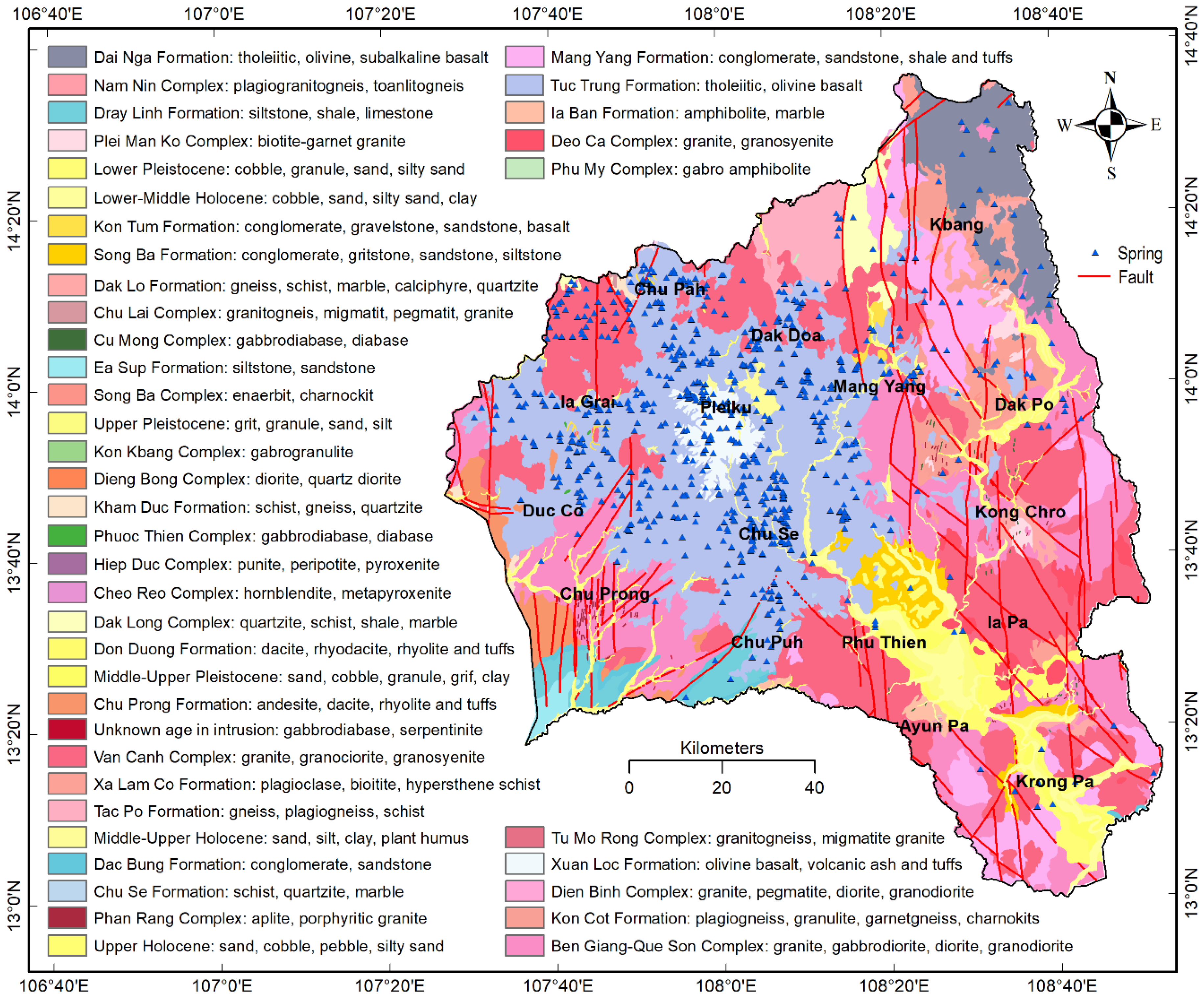
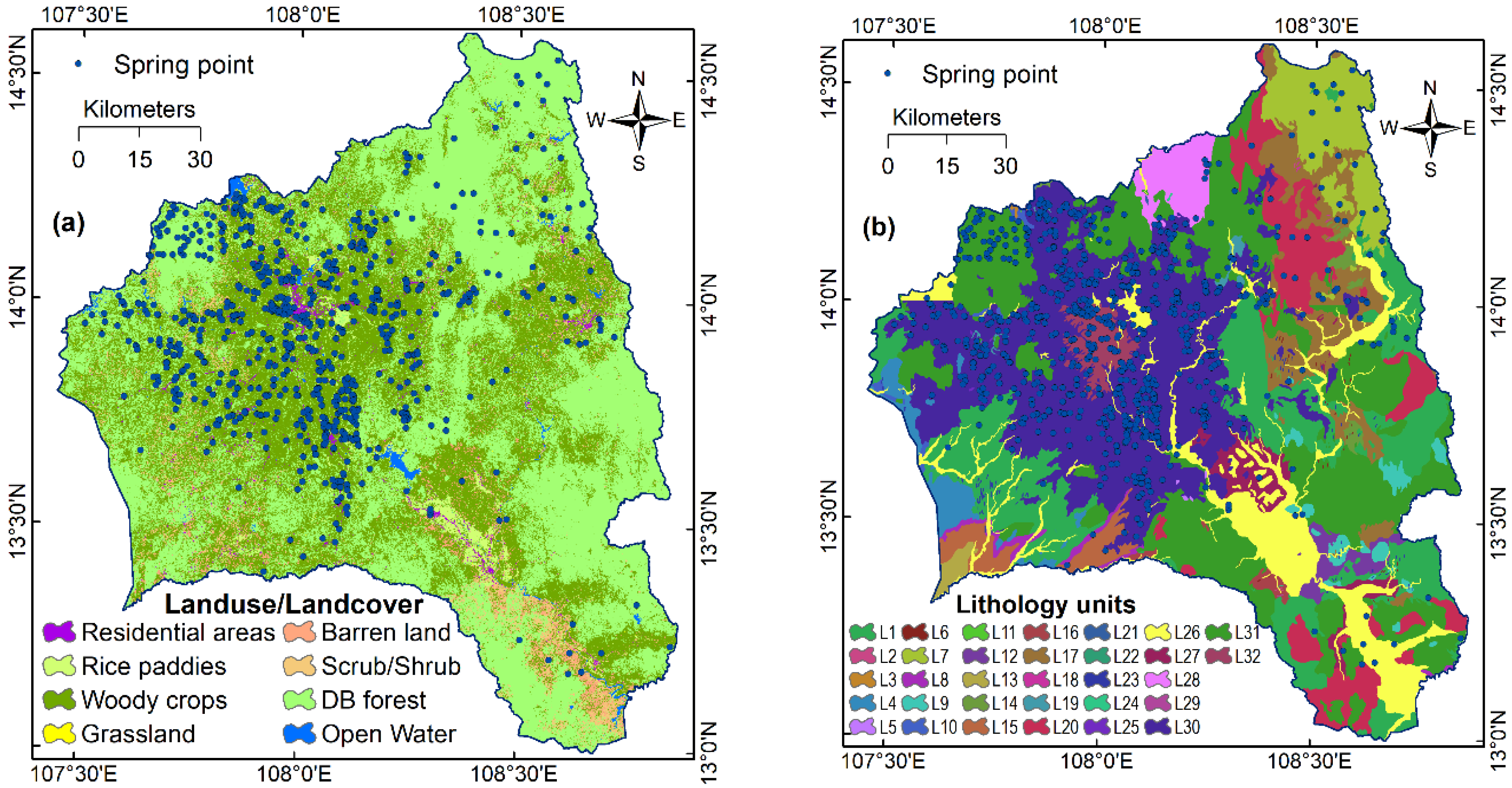
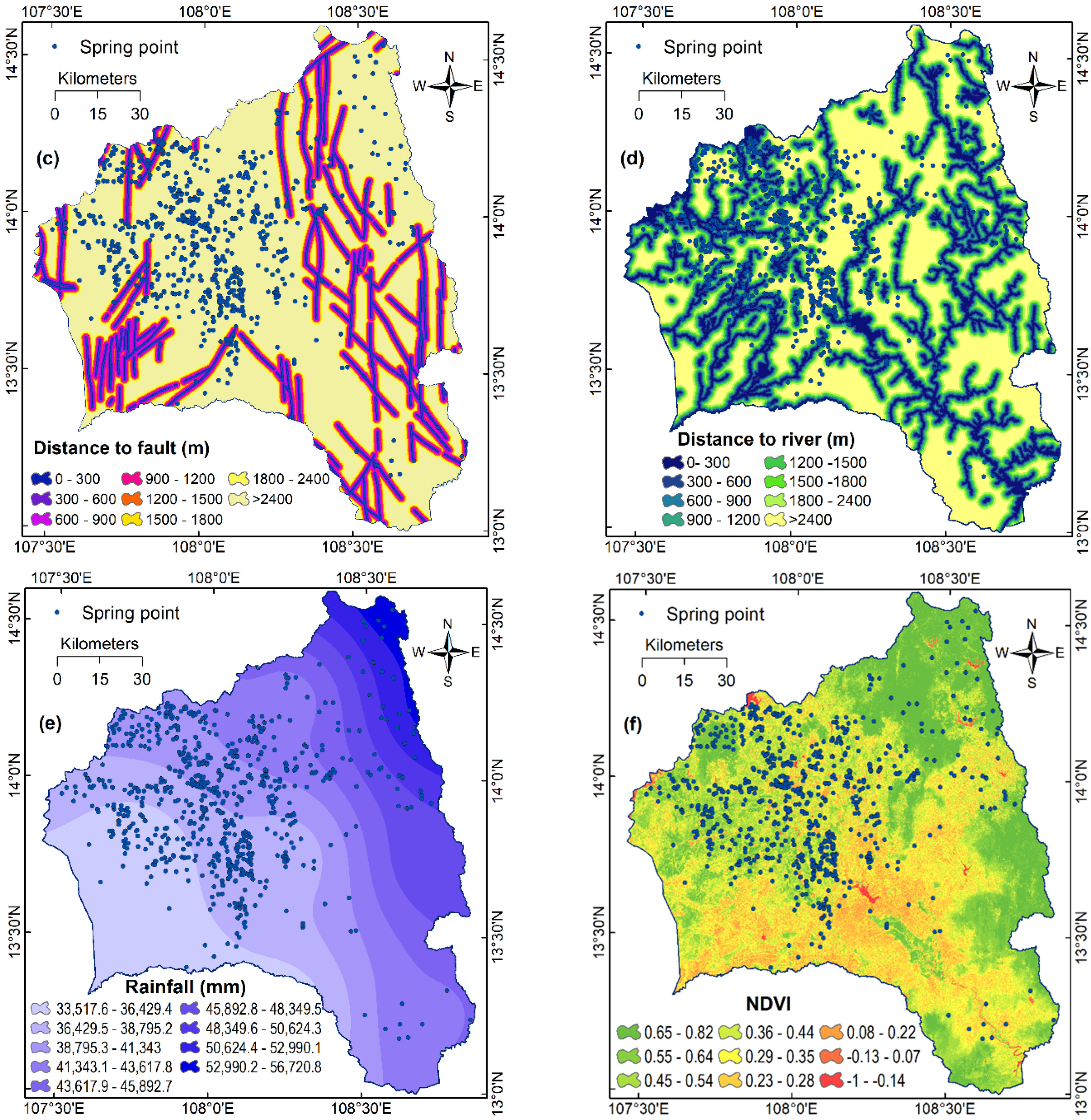
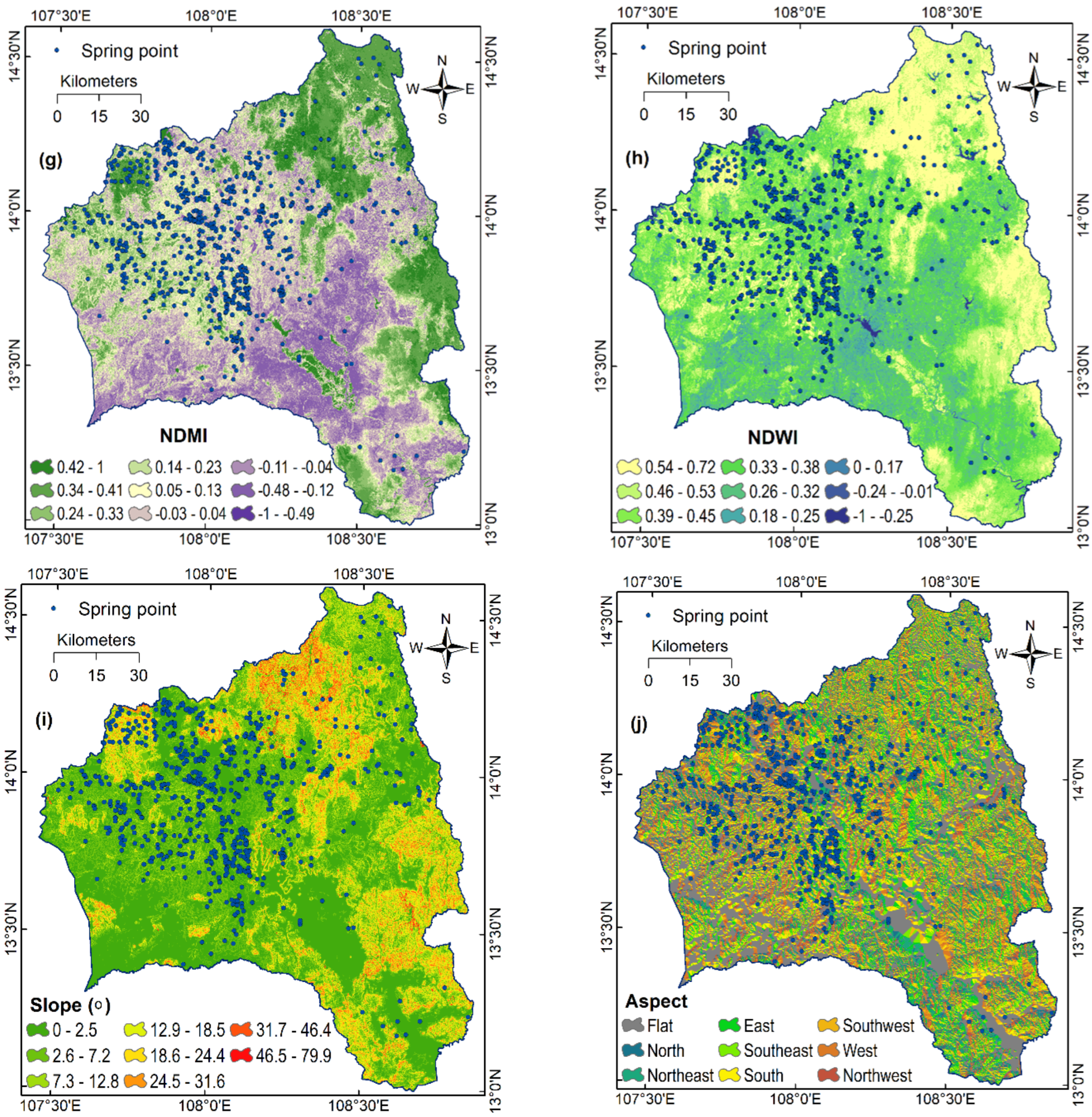

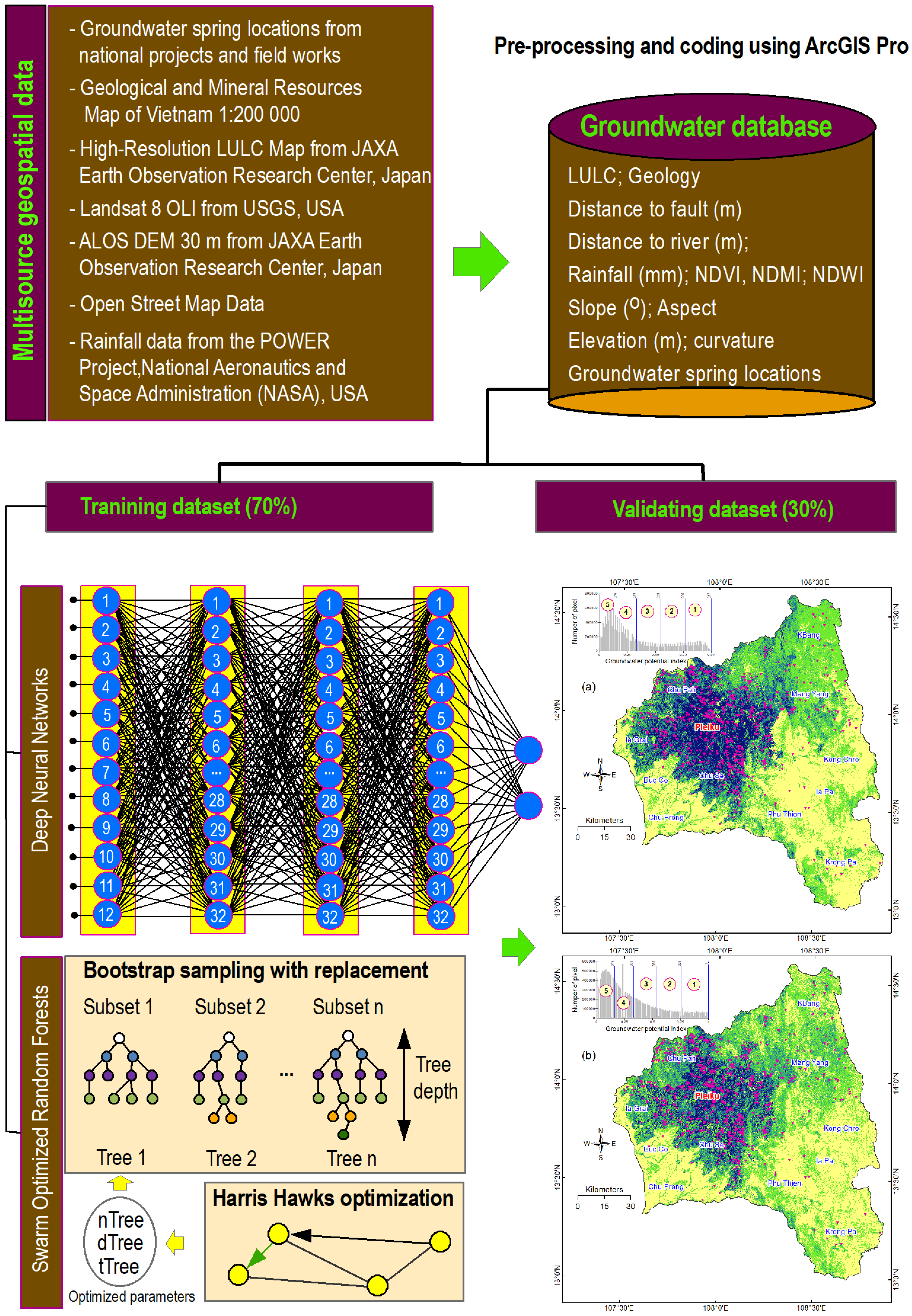
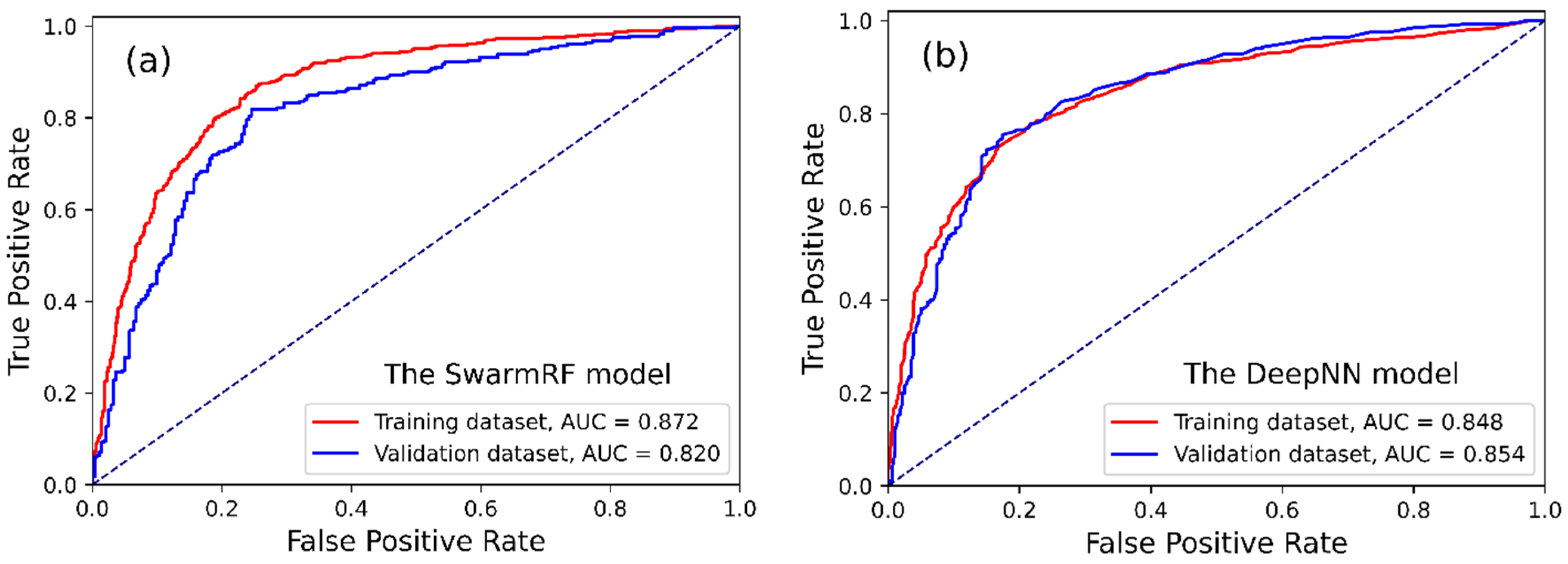
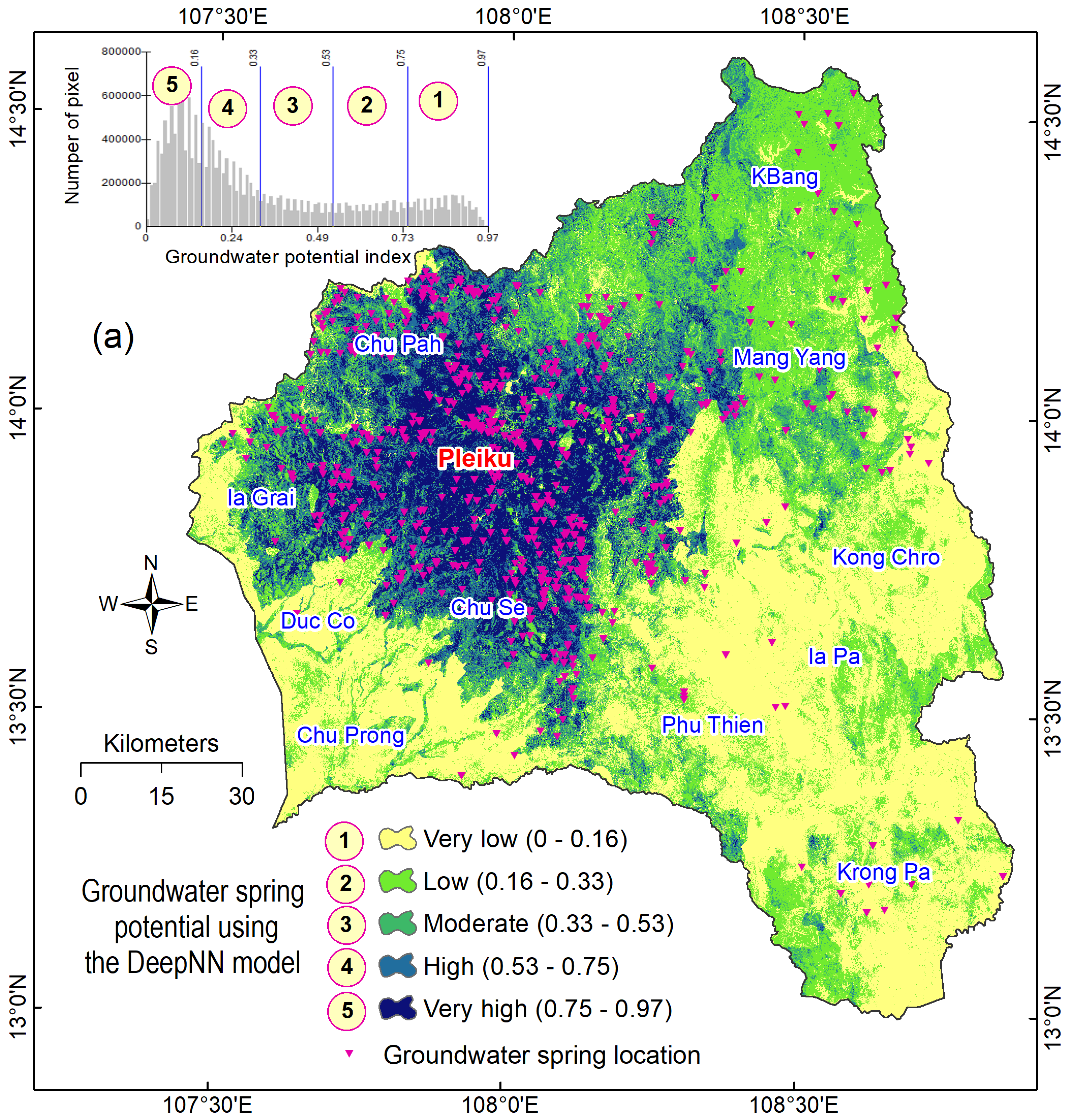
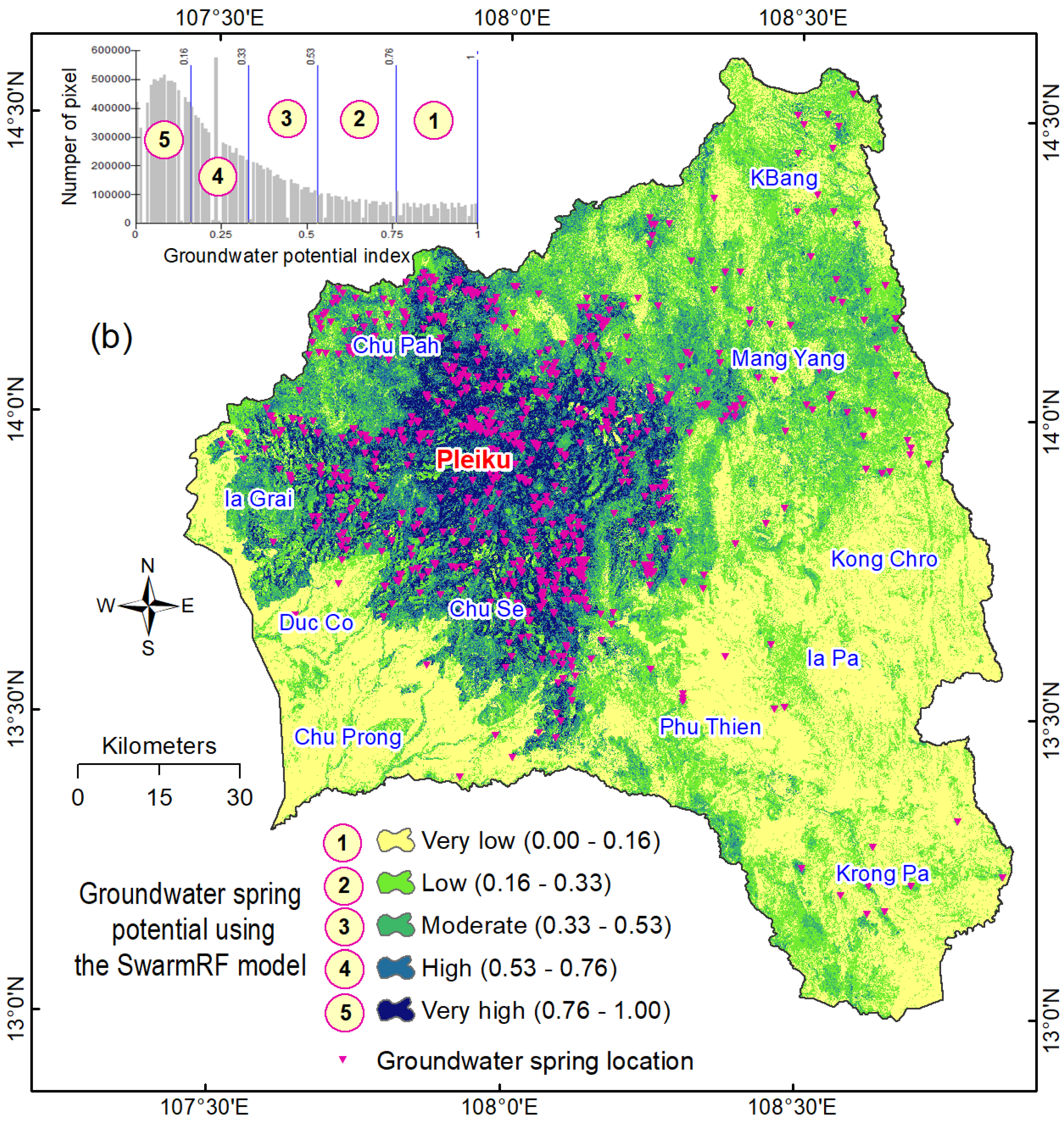
| No | Geological Units | Area (%) | Spring Location (%) | Main Lithologies |
|---|---|---|---|---|
| 1 | Tuc Trung formation | 25.77 | 68.87 | Tholeiitic, olivine basalt |
| 2 | Van Canh complex | 20.02 | 8.21 | Granite, granociorite, granosyenite |
| 3 | BG-QS complex | 14.63 | 2.24 | Granite, gabbrodiorite, diorite |
| 4 | Mang Yang formation | 6.48 | 1.17 | Conglomerate, sandstone, shale, and tuffs |
| 5 | Dai Nga formation | 4.93 | 1.71 | Tholeiitic, olivine, subalkaline basalt |
| 6 | Lower-Middle Holocene | 3.34 | 1.71 | Cobble, sand, silty sand, clay |
| 7 | Xa Lam Co formation | 2.4 | 0.75 | Plagioclase, biotite, hypersthene schist |
| 8 | Tac Po formation | 2.07 | 0.64 | Gneiss, plagiogneiss, schist |
| 9 | Kon Cot formation | 1.95 | 1.17 | Plagiogneiss, granulite, garnetgneiss, charnokits |
| 10 | Chu Prong formation | 1.61 | 0 | Andesite, dacite, rhyolite, and tuffs |
| 11 | Xuan Loc formation | 1.55 | 9.58 | Olivine basalt, volcanic ash, and tuffs |
| 12 | Upper Pleistocene | 1.53 | 0.32 | Grit, granule, sand, silt |
| 13 | Dray Linh formation | 1.52 | 0.32 | Siltstone, shale, limestone |
| 14 | Song Ba formation | 1.41 | 0.11 | Conglomerate, gritstone, sandstone, siltstone |
| 15 | Dak Long complex | 1.34 | 0.32 | Quartzite, schist, shale, marble |
| 16 | Upper Holocene | 1.22 | 0.32 | Sand, cobble, pebble, silty sand |
| 17 | Lower Pleistocene | 1.21 | 0.21 | Cobble, granule, sand, silty sand |
| 18 | Dak Lo formation | 1.06 | 0.11 | Gneiss, schist, marble, caliphate, quartzite |
| 19 | Deo Ca complex | 1.03 | 0.11 | Granite, granosyenite, siltstone |
| 20 | Middle-Upper Pleistocene | 0.94 | 0.21 | Sand, cobble, granule, grif, clay |
| 21 | Others | 3.99 | 1.92 | Dacite, rhyodacite, conglomerate, sand, silt |
| No. | Groundwater Spring Influencing Factor | Ranking Score |
|---|---|---|
| 1 | Geology | 0.250 |
| 2 | Elevation (m) | 0.181 |
| 3 | NDVI | 0.179 |
| 4 | NDMI | 0.169 |
| 5 | LULC | 0.153 |
| 6 | Rainfall (mm) | 0.151 |
| 7 | Distance to fault (m) | 0.120 |
| 8 | NDWI | 0.115 |
| 9 | Slope (°) | 0.087 |
| 10 | Aspect | 0.073 |
| 11 | Distance to river (m) | 0.062 |
| 12 | Curvature | 0.049 |
| Groundwater Spring Model with 10-Fold Cross-Validation | Measured Metrics | |||||||||||
|---|---|---|---|---|---|---|---|---|---|---|---|---|
| TP | TN | FP | FN | PPV | NPV | Sens | Spec | Acc | F-Score | Kappa | AUC | |
| Training phase | ||||||||||||
| DeepNN | 571 | 490 | 86 | 167 | 86.9 | 74.6 | 77.4 | 85.1 | 80.7 | 0.819 | 0.615 | 0.872 |
| SwarmRF | 507 | 516 | 150 | 141 | 77.2 | 78.5 | 78.2 | 77.5 | 77.9 | 0.777 | 0.557 | 0.848 |
| RF | 514 | 514 | 143 | 143 | 78.2 | 78.2 | 78.2 | 78.2 | 78.2 | 0.782 | 0.565 | 0.843 |
| Validating phase | ||||||||||||
| DeepNN | 224 | 214 | 57 | 67 | 79.7 | 76.2 | 77.0 | 79.0 | 77.9 | 0.783 | 0.559 | 0.820 |
| SwarmRF | 219 | 232 | 62 | 49 | 77.9 | 82.6 | 81.7 | 78.9 | 80.2 | 0.798 | 0.605 | 0.854 |
| RF | 208 | 229 | 73 | 52 | 74.0 | 81.5 | 80.0 | 75.8 | 77.8 | 0.769 | 0.555 | 0.840 |
| No. | Pairwise Model | z-Value | p-Value | Significance |
|---|---|---|---|---|
| 1 | DeepNN vs. SwarmRF | 2.553 | 0.011 | Yes |
| 2 | DeepNN vs. RF | 2.199 | 0.028 | Yes |
Disclaimer/Publisher’s Note: The statements, opinions and data contained in all publications are solely those of the individual author(s) and contributor(s) and not of MDPI and/or the editor(s). MDPI and/or the editor(s) disclaim responsibility for any injury to people or property resulting from any ideas, methods, instructions or products referred to in the content. |
© 2023 by the authors. Licensee MDPI, Basel, Switzerland. This article is an open access article distributed under the terms and conditions of the Creative Commons Attribution (CC BY) license (https://creativecommons.org/licenses/by/4.0/).
Share and Cite
Nhu, V.-H.; Hoa, P.V.; Melgar-García, L.; Tien Bui, D. Comparative Analysis of Deep Learning and Swarm-Optimized Random Forest for Groundwater Spring Potential Identification in Tropical Regions. Remote Sens. 2023, 15, 4761. https://doi.org/10.3390/rs15194761
Nhu V-H, Hoa PV, Melgar-García L, Tien Bui D. Comparative Analysis of Deep Learning and Swarm-Optimized Random Forest for Groundwater Spring Potential Identification in Tropical Regions. Remote Sensing. 2023; 15(19):4761. https://doi.org/10.3390/rs15194761
Chicago/Turabian StyleNhu, Viet-Ha, Pham Viet Hoa, Laura Melgar-García, and Dieu Tien Bui. 2023. "Comparative Analysis of Deep Learning and Swarm-Optimized Random Forest for Groundwater Spring Potential Identification in Tropical Regions" Remote Sensing 15, no. 19: 4761. https://doi.org/10.3390/rs15194761
APA StyleNhu, V.-H., Hoa, P. V., Melgar-García, L., & Tien Bui, D. (2023). Comparative Analysis of Deep Learning and Swarm-Optimized Random Forest for Groundwater Spring Potential Identification in Tropical Regions. Remote Sensing, 15(19), 4761. https://doi.org/10.3390/rs15194761








